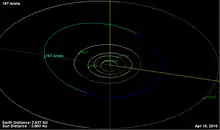197 Arete
Arete (minor planet designation: 197 Arete) is an asteroid in the asteroid belt. It has a very bright surface, even so when compared to other rocky S-type asteroid.
 Orbital diagram | |
| Discovery[1] | |
|---|---|
| Discovered by | Johann Palisa |
| Discovery date | 21 May 1879 |
| Designations | |
| (197) Arete | |
| Pronunciation | /əˈriːtiː/[2] |
Named after | Arete |
| A879 KA; 1934 RE1; 1950 DY | |
| Asteroid belt | |
| Orbital characteristics[3][4] | |
| Epoch 31 July 2016 (JD 2457600.5) | |
| Uncertainty parameter 0 | |
| Observation arc | 136.89 yr (50000 d) |
| Aphelion | 3.1882283 AU (476.95216 Gm) (Q) |
| Perihelion | 2.2897600 AU (342.54322 Gm) (q) |
| 2.7389941 AU (409.74769 Gm) (a) | |
| Eccentricity | 0.1640143 (e) |
| 4.53 yr (1655.7 d) | |
| 20.361539° (M) | |
| 0° 13m 2.744s / day (n) | |
| Inclination | 8.793773° (i) |
| 81.607160° (Ω) | |
| 246.46589° (ω) | |
| Earth MOID | 1.29448 AU (193.651 Gm) |
| Jupiter MOID | 2.16829 AU (324.372 Gm) |
| TJupiter | 3.314 |
| Physical characteristics[5] | |
| Dimensions | 29.18±2.4 km |
| 6.6084 h (0.27535 d)[3] 6.54 h[6] | |
| 0.4417±0.083[3] 0.442[7] | |
| S[8] | |
| 9.18[3] | |
It was discovered by J. Palisa on May 21, 1879, and named after Arete, the mother of Nausicaa in Homer's The Odyssey.[9] Every 18 years, this asteroid approaches within 0.04 AU of 4 Vesta. During these encounters, Vesta causes a gravitational perturbation of Arete, allowing the mass of Vesta to be directly determined.[10]
Photometric observations during 1984 showed a rotation period of 6.54 ± 0.02 hours and a brightness variation of 0.10 ± 0.01 in magnitude. The light curve shows "four well defined extrema with two asymmetric maxima".[11]
References
- "Discovery Circumstances: Numbered Minor Planets". Archived from the original on 17 November 1999.
- Benjamin Smith (1903) The Century Dictionary and Cyclopedia
- "JPL Small-Body Database Browser: 197 Arete" (2011-07-02 last obs). Archived from the original on 21 July 2011. Retrieved 18 August 2011.
- "AstDys: 197 Arete". Retrieved 18 August 2011.
- "The Asteroid Orbital Elements Database". astorb. Lowell Observatory.
- "Asteroid Lightcurve Data Base (LCDB) | PDS SBN Asteroid/Dust Subnode".
- "Infrared Astronomical Satellite (IRAS)". Archived from the original on 24 February 2005. Retrieved 24 February 2005.
- "Asteroid Lightcurve Data File, Updated March 1, 2001". Archived from the original on 20 July 2010.
- Schmadel, Lutz D. (2003). Dictionary of minor planet names. Vol. 1 (5th ed.). Berlin Heidelberg New York: Springer-Verlag. pp. 32–33. ISBN 3-540-00238-3.
- Hertz, Hans G. (19 April 1968). "Mass of Vesta". Science. 160 (3825): 299–300. Bibcode:1968Sci...160..299H. doi:10.1126/science.160.3825.299. PMID 17788233. S2CID 2555834.
- di Martino, M.; Zappala, V.; de Campos, J. A.; Debehogne, H.; Lagerkvist, C.-I. (September 1988), "Rotational properties and lightcurves of the minor planets 94, 107, 197, 201, 360, 451, 511 and 702", Astronomy and Astrophysics Supplement Series, 67 (1): 95–101, Bibcode:1987A&AS...67...95D.
External links
- 197 Arete at AstDyS-2, Asteroids—Dynamic Site
- 197 Arete at the JPL Small-Body Database
This article is issued from Wikipedia. The text is licensed under Creative Commons - Attribution - Sharealike. Additional terms may apply for the media files.